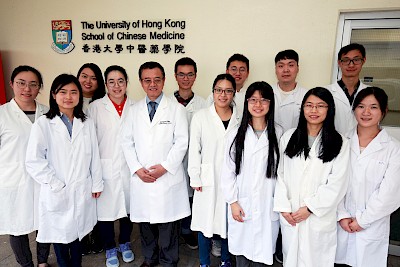By Liang-Jun Yan, Ph.D., University of North Texas Health Science Center
The University of Hong Kong is a world-class university in Asia, and Li Ka Shing Faculty of Medicine is one of the top medical schools in the world. The School of Chinese Medicine (SCM) is one of the institutions in Li Ka Shing Faculty of Medicine. The school aims to develop advanced teaching, research and clinical services for nurturing quality professionals in Chinese Medicine and bridging of traditional Chinese therapeutic arts to modern sciences. Medicinal herbs have abundant antioxidants and widely used for the treatment of stroke and neurodegenerative diseases. Thus, Free Radicals and Redox Biology and its applications are important research directions at SCM.
 Dr. Jiangang Shen is a tenured Professor and Associate Director for Research whose major research direction focuses on oxidative stress and redox signaling and natural antioxidants for stroke and neurodegenerative diseases. His research has attracted many high competitive research funds from Hong Kong and Mainland China and yielded high impact research publications and patents.
Dr. Jiangang Shen is a tenured Professor and Associate Director for Research whose major research direction focuses on oxidative stress and redox signaling and natural antioxidants for stroke and neurodegenerative diseases. His research has attracted many high competitive research funds from Hong Kong and Mainland China and yielded high impact research publications and patents.
Free radicals and redox signaling play important roles in the molecular regulations in the pathology of stroke and neurodegenerative diseases. Exploration of the underlying mechanisms would bring opportunity for developing new therapeutic approaches for those diseases. Dr. Shen’s group mainly works on the molecular regulations of reactive nitrogen species (RNS) and redox signaling cascades in blood-brain barrier disruption and brain damages in cerebral ischemia-reperfusion injury. The major challenge for free radical study is to make precise measurement for those reactive species. By collaborating with Dr. Yang Dan, Department of Chemistry, University of Hong Kong, Dr. Shen has made great efforts to develop high selective and sensitive probes for detecting ROS/RNS in biological systems in vivo and in vitro. The study yields several promising fluorescent probes for detecting peroxynitrite, superoxide and hypochlorous acid, etc. Dr. Shen has successfully applied those probes in different experimental systems such as the animal models including cerebral ischemia-reperfusion model, acute experimental autoimmune encephalomyelitis (EAE) model for multiple sclerosis, acute alcoholic liver injury and hepatic ischemia-reperfusion injury, etc.
Specifically, to understand the roles of free radicals and redox signaling in cerebral ischemia-reperfusion injury, Dr. Shen’s work focuses on understanding how RNS mediating the blood-brain barrier (BBB) disruption during cerebral ischemia injury. Activating matrix metalloproteinases (MMPs) is a key step in BBB disruption. MMPs are proteolytic zinc-containing enzymes responsible for degradation of the extracellular matrix around cerebral blood vessels and neurons. Free radicals can activate MMPs and subsequently induce the degradations of tight junctions (TJs), leading to BBB breakdown in cerebral ischemia-reperfusion injury.
The most important work in Dr. Shen’s group is to identify RNS-mediated caveolin-1 signaling cascades, subsequently inducing the activation of MMPs and the BBB disruption in cerebral ischemia-reperfusion injury. For example, he found that caveolin-1, a membrane integral protein located at caveolae, could prevent the degradation of TJ proteins and protect the BBB integrity by inhibiting RNS production and MMPs activity. His work indicates that the interactions of RNS, caveolin-1 and MMPs are critical signal pathways in the BBB disruption and infarction enlargement during cerebral ischemia-reperfusion injury. The interaction of caveolin-1 and RNS forms a positive feedback loop which provides amplified impacts on BBB dysfunction during cerebral ischemia-reperfusion injury. Dr. Shen then steps forward to examine the role of peroxynitrite in mediating hemorrhagic transformation (HT) induced by delayed thrombolysis in acute ischemic stroke animal models.
With the success of those studies, subsequently, Dr. Shen conducted a series of works to explore the natural and synthesized antioxidants and drug candidates for targeting RNS/caveolin-1/MMPs signaling cascades to protect the BBB, reduce infarction volume and improve neurological functions in the post-ischemic brains. Interestingly, caveolin-1 appears to be an important signaling molecule in CNS oriented lymphocytes diapedesis during EAE, leading neuroinflammatory process. RNS/caveolin-1/MMPs signaling cascades are also critical players in acute alcoholic liver injury. Therefore, further studies on the RNS-mediated cellular signaling cascades would explore new therapeutic strategies for those diseases.